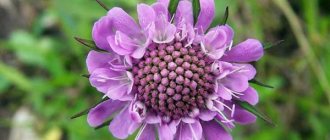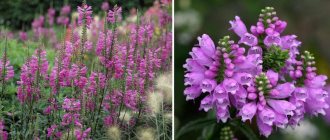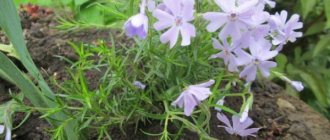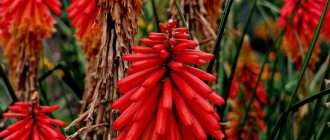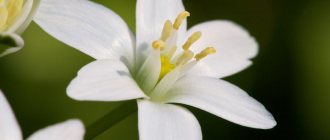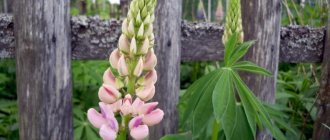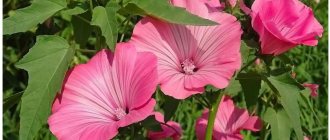Scabiosa is a flowering plant from the teasel subfamily, honeysuckle family. Popular names of the crop: “navel”, “shishkornik”, “cornflower”, “tease”, “needlecushion”. In nature, scabiosis can be found in different climatic zones of Europe and Asia. It is a shrub that can reach a height of 1 m. The leaves are dissected or lanceolate. Inflorescences can be of various shapes and colors, depending on the species.
Scabiosa is effectively used for growing in flower beds and garden plots. She is unpretentious and feels good in temperate latitudes. Thanks to its varietal diversity, this flower often becomes an integral part of the landscape.
Types and varieties for open ground
There are about 100 varieties of scabiosa. Most of them are obtained through selection. Among them there are both annuals and perennials. The types of scabiosa described below are most often cultivated in open ground.
Star-shaped
An annual native to Southern Europe, 15-45 cm high. The flowers are pale blue, collected in capitate inflorescences, located on long peduncles.
Dark purple
An annual species with branched straight stems, reaching a height of 1-1.2 m. It is also called widow's flower and Egyptian rose. Dark purple, white or pink flowers bloom on long, flexible stalks (depending on the variety).
Caucasian
Perennial 0.7-0.9 m high. The stems are strong and lightly branched. The leaves are lanceolate and form a basal rosette. The flowers are collected in capitate inflorescences up to 10 cm in diameter. They can be white, pink, or blue. The crop blooms in June-July.
Venechnaya
Low perennial up to 0.5 m tall. Stems are erect, with few branches. The stem leaves are on short petioles, pinnately divided. Flowers up to 3 cm in diameter are light bluish.
Japanese
A low perennial species up to 25 cm high, which is found mainly in the mountains. The plant bushes well and blooms for a long time. The flowers are mostly lilac.
Pale yellow
Tall herbaceous hybrid with feathery leaf blades. The flowers are pale yellow.
Description and features
Scabiosa is a perennial plant that grows up to one meter in height; its trunk sometimes becomes woody at the base of the stem. The stems themselves can be simple or branched, strong, and erect.
The leaves are pinnate, divided or dissected. The flowers are located at the very end of the stem and are either in the shape of a ball or half a ball. They are painted in a variety of colors.
Dark, almost black, blue, cornflower blue. There are scarlet, pink, burgundy. Also white, pale yellow, cream. This flower is highly valued by beekeepers. Thanks to its strong aroma, it attracts bees to flower stalks rich in nectar.
Also, scabiosis is widely used in homeopathy. Moreover, the entire shrub is suitable for use, from the root to the flowers. It contains saponin, tannin, and alkaloid.
Infusions of this plant are used to treat headaches, abdominal pain, and colds. Even for dog and snake bites, lotions made from brewed herbs are used. From the root of scabiosis, decoctions are made for rinsing the mouth for stomatitis, sore throat, and toothache.
Lotions for scabies, pustular diseases, skin rashes. It also serves as an expectorant and diuretic. Young leaves of the flower are used in cooking and added to salads.
Scabiosa flowers are used to treat certain diseases.
Growing from seeds to seedlings
Scabiosa can be grown in different ways. The most commonly used is seed. You can sow seeds directly into the ground or onto seedlings. In temperate climates, it is preferable to grow the flower in seedlings. The best time to sow seeds for seedlings is the end of March and the beginning of April.
Soil and container
Prepare a low container. Fill it with universal primer mixed with sand (2:1). Disinfect it by steaming in a water bath or using a solution of potassium permanganate. Lightly compact and level the soil. Make furrows, sow the seeds to a depth of 0.5 cm. Spray the crops with a spray bottle. Cover the top of the container with film or glass. Place in a bright place at a temperature of +20..22°C.
Seedling care
Shoots may appear after 1-3 weeks, depending on the type of scabiosis. The cover must be removed daily for ventilation and removal of condensation. When sprouts appear, it can be removed. Make sure the soil is moist, but do not make it waterlogged. Light for seedlings needs to be bright, but diffused.
After the formation of 2-3 true leaves, the seedlings are planted in individual pots. After this, the seedlings need to begin to harden. She is taken outside first for 1 hour. Gradually the hardening time is increased.
Transplanting
Seedlings are planted on the site in late May - early June. Before planting, it is recommended to fertilize the soil with rotted manure. Prepare holes of such depth that the seedlings fit in them along with the earthen ball. The optimal distance between plants is 20-25 cm. Carefully remove the seedlings from the pots so as not to damage the roots. Place in the hole, press down lightly and sprinkle with soil.
Planting seeds in open ground
If the climate allows, spring is early and warm, you don’t have to waste time growing seedlings and sow seeds directly in the flower garden. It is better to do this in mid-April if there is no risk of night frosts.
Choice of location and lighting
Scabiosa can only grow well in light areas. Therefore, you need to choose a sunny place for sowing. It must be protected from strong winds. It is better that the site is elevated without nearby groundwater. Scabiosa does not like marshy soil. Therefore, it must be well equipped with a drainage system. This especially applies to perennials.
Landing rules
In order for scabiosa to grow well and bloom profusely, you need to prepare fertile, loose soil before sowing. It should be neutral acidity. In acidic soils the plant may die. It is recommended to dig up the area in the fall. 2 weeks before sowing, the area must be cleared of weeds and the soil loosened. Make shallow furrows at intervals of 35-40 cm and water. Place the seeds, keeping a distance of 5 cm between them. Sprinkle with soil. When the seedlings grow, they need to be thinned out, leaving the strongest specimens with intervals of 30 cm between each.
Growing conditions
Under natural conditions, scabiosis is common on the slopes of mountains, its individual species are found even at an altitude of 2000 m. But it also grows well in meadows, on the edges of forests and wherever the soil is well drained and has a neutral or alkaline reaction. The composition of the soil does not play a big role. It is only important to remember that stagnant moisture and acidic soil are destructive for the plant.
Wild scabiosa is adapted to unfavorable conditions. It easily tolerates drought and exposure to direct sunlight. It grows well in partial shade and overwinters under snow. Ornamental plant varieties have inherited most of the listed qualities and are therefore considered very unpretentious.
Wild scabiosa
ON A NOTE. In culture, scabiosa is grown in open sunny areas, possibly on hills or on southern slopes where there is no flooding. The site must be protected from prevailing winds, as the plant is sensitive to gusts of air.
Time to sow
Scabiosa is planted with seeds in the spring, when the ground has already warmed up a little under the sun. The optimal time is mid-April, if the winter is not long. In the south, you can start sowing at the end of March, around the same time as carrots and beets. There is no need to be afraid of frost; the seeds are not afraid of the cold.
In regions with late spring, scabiosa is planted using seedlings. In this case, seeds are sown for forcing in a greenhouse at the beginning of March or even at the end of winter. It is also practiced to sow before winter, in which case the first shoots will appear a couple of weeks earlier.
The exact sowing time is determined by the climatic characteristics of the region
How to prepare the ground for scabiosis
Scabiosa does not tolerate heavy, clay soils. She needs a light, nutritious substrate in which her roots will “breathe”. Therefore, if possible, prepare the area for sowing in advance so that by spring the organic matter added to the soil will rot and release all the necessary nutrients. Along with organic fertilizers (for example, compost), you can add a little gravel and sand to the soil (2-3 buckets per 1 m2) - this will make the growth conditions closer to natural.
REFERENCE. If it is planned to sow the plant before winter, the site is dug up approximately 30 days before the main work.
Wood ash reduces soil acidity
Since scabiosa prefers slightly alkaline soils, it would be useful to add a little wood (about 200 g/m2) or peat ash (350 g/m2) to the soil. Instead of ash, you can use slaked lime or dolomite flour. From an environmental point of view, dolomite flour is better than lime, although the effect of its use is noticeable somewhat later.
Prices for slaked lime
slaked lime
How to prepare seed
Preparing flower seeds is not a mandatory procedure before sowing, however, a few simple techniques will significantly increase their germination and help grow healthy seedlings:
This is what scabiosa seeds look like
Outdoor care
After planting, caring for the plant on the site does not require complex manipulations. Scabiosa is absolutely unpretentious and can tolerate drought and cold weather.
Watering
The flower requires moderate watering. The soil does not need to remain wet all the time. It is enough to water the bush once a week if there is no rain. But if the weather is hot, dry, then it is doubled. After watering, the soil should be loosened.
Feeding and fertilizer
During the growing season, scabiosis needs regular feeding 2 times a month. You can take any universal mixtures for ornamental crops. Organic matter can be added only before planting. At the flowering stage, potassium-phosphorus fertilizers are applied weekly.
Care during and after flowering
The flowering time of scabiosa may vary depending on the variety.
As a rule, this is July-August. The flowers are collected in capitate inflorescences, which are formed on long peduncles. Their color can be varied. Advice! Dried buds must be removed. This prolongs the flowering of the crop and prevents self-seeding.
Trimming
In order for the scabiosa to remain attractive until late autumn, it needs to be pinched periodically. This stimulates the growth of young side shoots and improves bushiness. All dried branches and flowers should be cut out immediately. At the end of autumn, the stems of perennial species are cut off completely.
Loosening the soil
The soil under the bush needs to be regularly loosened and weeded. This is necessary for better penetration of oxygen to the roots, scabiosis will grow better.
Family ties
Despite extensive family ties throughout the planet, only a few of the most interesting and decorative species of scabiosis have been introduced into culture. It was they who provided the genetic material for breeding garden forms of the crop.
- Scabiosa Caucasica is a textbook representative of the genus, which has long been firmly established in our gardens. This is a classic perennial 50–60 cm high. It forms a lush bush, at the peak of flowering it simultaneously blooms up to 30 white, cream, light ocher flowers - it’s not a shame to plant one like this in a front flower bed! Served as the basis for numerous varieties and hybrids with intense blue, violet, and purple colors. A distinctive feature is the long flowering period, over 40 days.
Bush of perennial Caucasian scabiosa in bloom - Scabiosa japonica is a perennial native to the islands of the Japanese archipelago. This is a cold-resistant crop that grows on sunny mountain slopes and meadows. In gardens it is often cultivated as a biennial plant. Forms a tall (up to 90 cm), lightly branched bush. The inflorescences are small, rounded and convex with protruding stamens, similar to pinheads. Garden forms come in a variety of colors.
Japanese species with pincushion-like flowers - Scabiosa purpurea is grown as a biennial or annual plant - planted in early spring, it will bloom in the same year, in early summer - the next season. The species is represented by a large number of varieties and hybrids, among which there are tall (up to 1 m), bushy (50–60 cm) and low-growing (25–30 cm) groups, with regular and double inflorescences. The color palette is varied - from pale pink and bluish to crimson and dark purple.
Terry inflorescences of purple colors are spectacular in a “bouquet” flower garden - Pale yellow scabiosa is one of the most unpretentious and cold-resistant natural species. The bush, almost a meter high, is covered with numerous heads of a very delicate yellowish hue. The summer flower has a long flowering period until mid-autumn and a pleasant aroma. Suitable as a background ornamental crop for bright, showy flowers.
Scabiosa pale yellow in nature - Scabiosa pigeon is a European relict species found in floodplain meadows, mountain slopes, and along river banks. A perennial plant that is often cultivated as a biennial. The flower heads on long stems are not very large, but have an interesting red-violet color and bloom gradually - from the edges to the middle. The flowering period is 1.5 months, starting from mid-July.
Protection from pests and diseases
The flower is quite resistant to most diseases and pests. The plant only tolerates excess moisture with difficulty. Due to waterlogging of the soil, fungal infections (powdery mildew, root rot) can develop. If the plant begins to wither, you need to pay attention to the humidity. At the initial stage of the disease, you can treat the bush with a product containing sulfur. But if the rot has seriously affected the scabiosa, then it is better to dig it up and burn it, and disinfect the area.
Among the pests, the flower can be affected by aphids and garden slugs. To prevent their appearance, it is necessary to mulch the soil around the bush and treat it with a weak saline solution.
Reproduction
For annual species, only seed propagation is used. Perennials can also be propagated vegetatively - by dividing the bush and cuttings. Dig up a bush that is at least 3 years old. Remove soil from roots. Using a sharp and disinfected instrument, cut the bush into several parts. Each one should have at least 2 shoots, and there should also be strong roots. Prepare the area in advance. Dig holes of suitable size. Plant cuttings in them and water well. The procedure is best carried out in early spring or autumn. Dividing the bush allows you to rejuvenate scabiosis and stimulate its growth.
Before flowering begins, the plant can be propagated using cuttings. Using a sharp knife, cut off the young root shoot with a piece of root. Plant it in a container with loose substrate. Water the cutting regularly until it takes root. When young leaves appear, the plant can be planted on the site.
Autumn care, seed collection and wintering
Annual species of scabiosa are dug up and thrown away in the fall. If necessary, seeds are collected at the end of summer. Select suitable inflorescences and tie them with gauze to prevent self-seeding. When the seed pods are completely dry, they are cut off. The seeds are poured out of the boxes and stored in paper bags in a dry place.
Perennials are left to overwinter on the site. After flowering has finished and the leaves have dried, the stems are cut to soil level. Scabiosa can remain without shelter. But hybrid varieties can freeze. Therefore, for the winter they are covered with dry leaves or straw. In spring the cover is removed.
Scabiosa in landscape design
Scabiosa is used to design ridges, mixed borders, alpine slides, and mixed plantings in flower beds. Low-growing varieties decorate sidewalk paths.
Delicate pastel scabiosa flowers go well with:
- phlox;
- irises;
- peonies;
- gypsophila;
- sage;
- asters.
Floral compositions are complemented with herbs, cereals, and stones. Scabiosa is often planted for cutting. Flowers can remain fresh for 5-7 days. Therefore, they are often included in holiday bouquets.
Scabiosa is one of the most popular flowers for growing outdoors. It is drought-resistant, winter-hardy, and easy to care for. The flower is also widely used in landscape design.
Below is a video, after watching which you can find out more useful information about planting and growing Scabiosa on the site:
Proper planting
Nothing will brighten up your garden like a light and colorful scabiosa. Planting and caring for this magnificent plant in open ground will not require any complex manipulations from you.
Plant scabiosa in fertile soil
An open sunny area is suitable for growing it. The soil should be chosen very carefully. Drained calcareous soil rich in various nutrients will be optimal for planting.
Attention! Do not plant scabiosa in very acidic soil, as it can cause the death of the plant.
Sowing seeds of perennial scabiosis in open ground at a shallow depth occurs in the spring (April). Keep a distance of about 30-45 cm, and 40 cm between the rows themselves. After sowing, the soil should be slightly moistened. Additionally, the seeds are covered with a layer of compost. Before planting seeds in open ground, gravel, humus, and manure can be added to the soil.
